Dr. Weninger Recent Publications
- Combining single-molecule and structural studies reveals protein and DNA conformations and assemblies that govern DNA mismatch repair. Dorothy A. Erie, Keith R. Weninger. Current Opinion in Structural Biology, 2024.
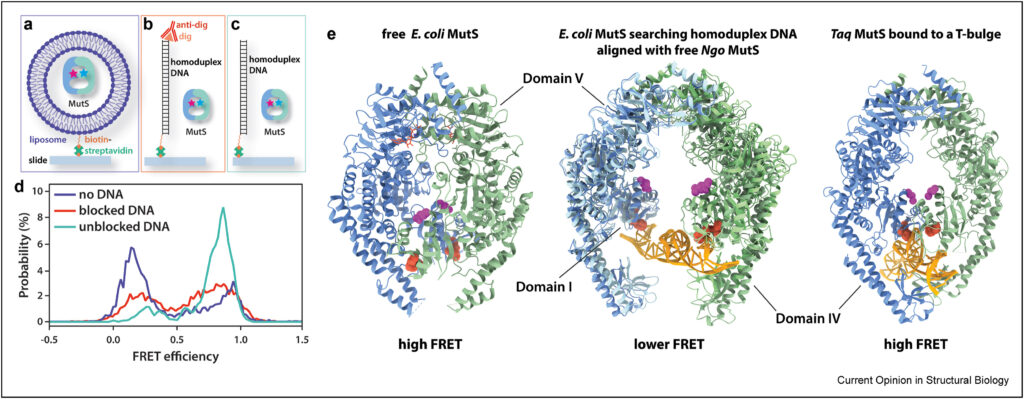
Abstract: DNA mismatch repair (MMR) requires coordinated sequential actions of multiple proteins during a window of time after the replication apparatus makes an error and before the newly synthesized DNA undergoes chromosome compaction and/or methylation of dGATC sites in some γ-proteobacteria. In this review, we focus on the steps carried out by MutS and MutL homologs that initiate repair. We connect new structural data to early and recent single-molecule FRET and atomic force microscopy (AFM) studies to reveal insights into how signaling within the MMR cascade connects MutS homolog recognition of a mismatch to downstream repair. We present unified models of MMR initiation that account for the differences in the strand discrimination signals between methyl- and non-methyl-directed MMR.
- Reply to: On the statistical foundation of a recent single molecule FRET benchmark. Markus Götz, Anders Barth, Søren S. -R. Bohr, et al. Nature Communications, 2024.
Abstract: 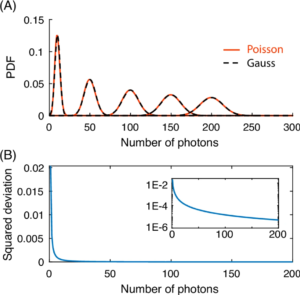 In their ‘Matters Arising’ manuscript, Saurabh et al. discuss two issues related to single-molecule Förster resonance energy transfer (smFRET) experiments: the use of the Gaussian noise approximation and spectral crosstalk. Their arguments are based on simulations obtained with parameters that differ significantly from the typical conditions measured experimentally, and, thus, from the regime included in the original study (Götz et al.1). In addition, they make claims about our multi-lab blind study that we would like to rectify. In Table 1, we provide a list of specific statements made by Saurabh et al. with our respective explanations.
In their ‘Matters Arising’ manuscript, Saurabh et al. discuss two issues related to single-molecule Förster resonance energy transfer (smFRET) experiments: the use of the Gaussian noise approximation and spectral crosstalk. Their arguments are based on simulations obtained with parameters that differ significantly from the typical conditions measured experimentally, and, thus, from the regime included in the original study (Götz et al.1). In addition, they make claims about our multi-lab blind study that we would like to rectify. In Table 1, we provide a list of specific statements made by Saurabh et al. with our respective explanations.
- Structural and Dynamical Properties of Nucleic Acid Hairpins Implicated in Trinucleotide Repeat Expansion Diseases. F Pan, P Xu, C Roland, C Sagui, K Weninger. Biomolecules, 14 (10), 1278, 2024.
Abstract: 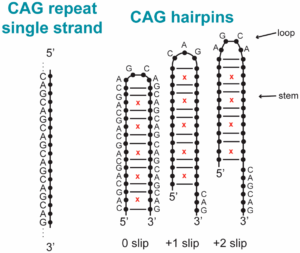 Dynamic mutations in some human genes containing trinucleotide repeats are associated with severe neurodegenerative and neuromuscular disorders—known as Trinucleotide (or Triplet) Repeat Expansion Diseases (TREDs)—which arise when the repeat number of triplets expands beyond a critical threshold. While the mechanisms causing the DNA triplet expansion are complex and remain largely unknown, it is now recognized that the expandable repeats lead to the formation of nucleotide configurations with atypical structural characteristics that play a crucial role in TREDs. These nonstandard nucleic acid forms include single-stranded hairpins, Z-DNA, triplex structures, G-quartets and slipped-stranded duplexes. Of these, hairpin structures are the most prolific and are associated with the largest number of TREDs and have therefore been the focus of recent single-molecule FRET experiments and molecular dynamics investigations. Here, we review the structural and dynamical properties of nucleic acid hairpins that have emerged from these studies and the implications for repeat expansion mechanisms. The focus will be on CAG, GAC, CTG and GTC hairpins and their stems, their atomistic structures, their stability, and the important role played by structural interrupts.
Dynamic mutations in some human genes containing trinucleotide repeats are associated with severe neurodegenerative and neuromuscular disorders—known as Trinucleotide (or Triplet) Repeat Expansion Diseases (TREDs)—which arise when the repeat number of triplets expands beyond a critical threshold. While the mechanisms causing the DNA triplet expansion are complex and remain largely unknown, it is now recognized that the expandable repeats lead to the formation of nucleotide configurations with atypical structural characteristics that play a crucial role in TREDs. These nonstandard nucleic acid forms include single-stranded hairpins, Z-DNA, triplex structures, G-quartets and slipped-stranded duplexes. Of these, hairpin structures are the most prolific and are associated with the largest number of TREDs and have therefore been the focus of recent single-molecule FRET experiments and molecular dynamics investigations. Here, we review the structural and dynamical properties of nucleic acid hairpins that have emerged from these studies and the implications for repeat expansion mechanisms. The focus will be on CAG, GAC, CTG and GTC hairpins and their stems, their atomistic structures, their stability, and the important role played by structural interrupts.
- A nanophotonic interferometer. A Ghaffari, S Kashani, K Do, K Weninger, R Riehn. Nanotechnology, 34 (18), 185201, 2023.

Abstract: The transmission of light through sub-wavelength apertures (zero-mode waveguides, ZMW) in metal films is well-explored. It introduces both an amplitude modulation as well as a phase shift to the oscillating electromagnetic field. We propose a nanophotonic interferometer by bringing two ZMW (∼100 nm diameter) in proximity and monitoring the distribution of transmitted light in the back-focal plane of collecting microscope objective (1.3 N.A.). We demonstrate that both an asymmetry induced by the binding of a quantum dot in one of the two ZMW, as well as an asymmetry in ZMW diameter yield qualitatively similar transmission patterns. We find that the complex pattern can be quantified through a scalar measure of asymmetry along the symmetry axis of the aperture pair. In a combined experimental and computational exploration of detectors with differing ZMW diameters, we find that the scalar asymmetry is a monotonous function of the diameter difference of the two apertures, and that the scalar asymmetry measure is higher if the sample is slightly displaced from the focal plane of the collecting microscope objective. An optimization of the detector geometry determined that the maximum response is achieved at an aperture separation that is comparable to the wavelength on the exit side of the sensor. For small separations of apertures, on the order of a quarter of the wavelength and less, the signal is strongly polarization dependent, while for larger separations, on the order of the wavelength or larger, the signal becomes essentially polarization-independent.
- Ex vivo analysis of ultraviolet radiation transmission through ocular media and retina in select species. Nicole E. Himebaugh, James B. Robertson, Keith Weninger, Brian C. Gilger, Bjorn Ekesten, and Annie Oh. Experimental Eye Research, 2023.
Abstract: 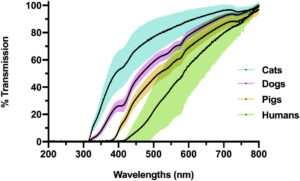 The aim of this study was to assess the transmission of the ultraviolet (UV) radiation (200–400 nm) through intact enucleated globes of different species (dogs, cats, pigs, rabbits, horses, and humans) using spectrophotometry. Globes of cats (n = 6), dogs (n = 18), pigs (n = 10), rabbits (n = 6), horses (n = 10), and humans (n = 4) were analyzed. A 5–10 mm circular area of sclera and choroid from the posterior aspect of the globe was removed under a surgical microscope, leaving the retina intact in all species except the horse. Glass coverslips were added in horses and rabbits due to retinal and globe fragility. The %T of wavelengths from 200 to 800 nm were measured through the ocular media (cornea, aqueous humor, lens, and vitreous humor) and retina, and compared between species. The globes of cats and dogs allowed the most amount of UV radiation transmission, while those of pigs and humans allowed the least amount of UV radiation transmission. A small amount of UV radiation transmission through the ocular media was detected in the rabbit and horse. Results from this study will support further vision research that may be used to train companion, working, and service animals.
The aim of this study was to assess the transmission of the ultraviolet (UV) radiation (200–400 nm) through intact enucleated globes of different species (dogs, cats, pigs, rabbits, horses, and humans) using spectrophotometry. Globes of cats (n = 6), dogs (n = 18), pigs (n = 10), rabbits (n = 6), horses (n = 10), and humans (n = 4) were analyzed. A 5–10 mm circular area of sclera and choroid from the posterior aspect of the globe was removed under a surgical microscope, leaving the retina intact in all species except the horse. Glass coverslips were added in horses and rabbits due to retinal and globe fragility. The %T of wavelengths from 200 to 800 nm were measured through the ocular media (cornea, aqueous humor, lens, and vitreous humor) and retina, and compared between species. The globes of cats and dogs allowed the most amount of UV radiation transmission, while those of pigs and humans allowed the least amount of UV radiation transmission. A small amount of UV radiation transmission through the ocular media was detected in the rabbit and horse. Results from this study will support further vision research that may be used to train companion, working, and service animals.
- Frustration Between Preferred States of Complementary Trinucleotide Repeat DNA Hairpins Anticorrelates with Expansion Disease Propensity. Pengning Xu, Jiahui Zhang, Feng Pan, Chelsea Mahn, Christopher Roland, Celeste Sagui, and Keith Weninger. Journal of Molecular Biology, 2023.
Abstract: 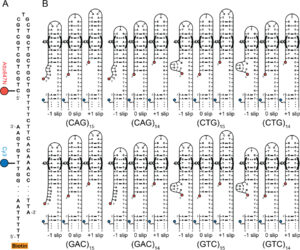 DNA trinucleotide repeat (TRs) expansion beyond a threshold often results in human neurodegenerative diseases. The mechanisms causing expansions remain unknown, although the tendency of TR ssDNA to self-associate into hairpins that slip along their length is widely presumed related. Here we apply single molecule FRET (smFRET) experiments and molecular dynamics simulations to determine conformational stabilities and slipping dynamics for CAG, CTG, GAC and GTC hairpins. Tetraloops are favored in CAG (89%), CTG (89%) and GTC (69%) while GAC favors triloops. We also determined that TTG interrupts near the loop in the CTG hairpin stabilize the hairpin against slipping. The different loop stabilities have implications for intermediate structures that may form when TR-containing duplex DNA opens. Opposing hairpins in the (CAG) ∙ (CTG) duplex would have matched stability whereas opposing hairpins in a (GAC) ∙ (GTC) duplex would have unmatched stability, introducing frustration in the (GAC) ∙ (GTC) opposing hairpins that could encourage their resolution to duplex DNA more rapidly than in (CAG) ∙ (CTG) structures. Given that the CAG and CTG TR can undergo large, disease-related expansion whereas the GAC and GTC sequences do not, these stability differences can inform and constrain models of expansion mechanisms of TR regions.
DNA trinucleotide repeat (TRs) expansion beyond a threshold often results in human neurodegenerative diseases. The mechanisms causing expansions remain unknown, although the tendency of TR ssDNA to self-associate into hairpins that slip along their length is widely presumed related. Here we apply single molecule FRET (smFRET) experiments and molecular dynamics simulations to determine conformational stabilities and slipping dynamics for CAG, CTG, GAC and GTC hairpins. Tetraloops are favored in CAG (89%), CTG (89%) and GTC (69%) while GAC favors triloops. We also determined that TTG interrupts near the loop in the CTG hairpin stabilize the hairpin against slipping. The different loop stabilities have implications for intermediate structures that may form when TR-containing duplex DNA opens. Opposing hairpins in the (CAG) ∙ (CTG) duplex would have matched stability whereas opposing hairpins in a (GAC) ∙ (GTC) duplex would have unmatched stability, introducing frustration in the (GAC) ∙ (GTC) opposing hairpins that could encourage their resolution to duplex DNA more rapidly than in (CAG) ∙ (CTG) structures. Given that the CAG and CTG TR can undergo large, disease-related expansion whereas the GAC and GTC sequences do not, these stability differences can inform and constrain models of expansion mechanisms of TR regions.
